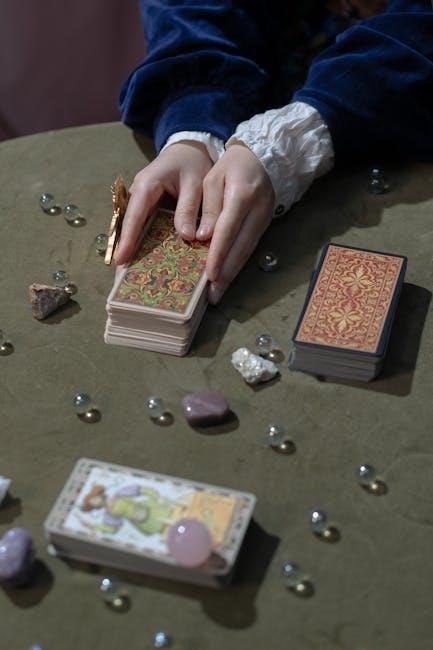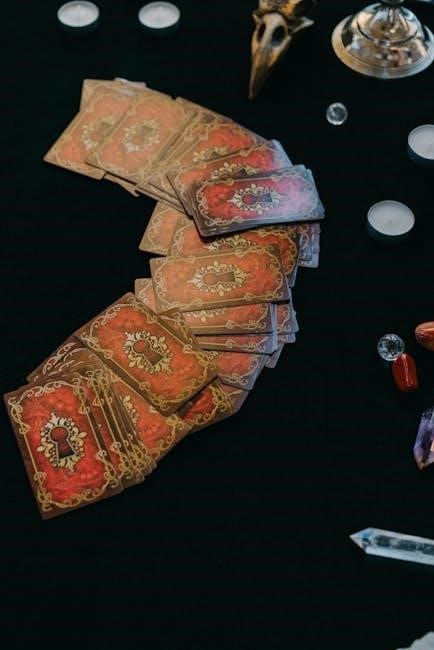Tarot cards, originating in 15th-century Italy, are a powerful tool for self-reflection and guidance. Each card holds symbolic imagery, offering insights into emotions, decisions, and life paths. By understanding their meanings, tarot empowers individuals to navigate challenges and foster personal growth through introspection and intuition.
1.1 What Are Tarot Cards and Their Origins
Tarot cards are a deck of 78 cards, each carrying symbolic imagery and meanings. Originating in 15th-century Italy as a game, they later evolved into tools for divination and self-reflection. The deck includes the Major Arcana, representing major life themes, and the Minor Arcana, reflecting everyday situations. Their rich history and versatility have made them a popular medium for introspection and guidance.
1.2 The Structure of a Tarot Deck: Major and Minor Arcana
A standard tarot deck consists of 78 cards, divided into the Major Arcana and Minor Arcana. The Major Arcana contains 22 cards, each representing major life events and spiritual themes. The Minor Arcana has 56 cards, split into four suits—Wands, Cups, Swords, and Pentacles—each symbolizing elements of life: creativity, emotions, thoughts, and material aspects. Together, they offer a comprehensive guide for self-reflection and insight.
1.3 How Tarot Cards Are Used for Reflection and Guidance
Tarot cards serve as a mirror to inner thoughts and emotions, aiding in self-reflection. By interpreting their symbolic meanings, individuals gain clarity on life decisions and challenges. Tarot encourages open-ended questioning, fostering personal growth and empowerment. Regular use helps users connect with their intuition, guiding them toward balanced and mindful life choices.

Preparing for a Tarot Reading
Creating a calm environment, choosing a resonant deck, and attuning to the cards are essential steps. Cleansing the space and shuffling the deck helps establish a clear connection for meaningful insights.
2.1 Setting the Mood and Creating a Conducive Environment
Creating a serene atmosphere is crucial for a meaningful tarot reading. Dim lighting, candles, and comfortable seating help set the mood. A quiet, clutter-free space allows focus and intuition to flow freely. Personalizing the environment with meaningful objects enhances the connection to the cards and the reading process.
2.2 Choosing the Right Tarot Deck for Your Needs
Selecting a tarot deck that resonates with you is vital for meaningful readings. Consider decks with imagery and themes that align with your intentions or personality. Some decks, like those by Lori Field, offer unique symbolic art, while others focus on traditional or modern interpretations. Explore options to find a deck that feels intuitive and inspiring for your practice.
2.3 How to Attune to Your Tarot Cards
Attuning to your tarot cards creates a personal connection, enhancing their responsiveness. Begin by shuffling the deck while focusing on your intent. You can also meditate with the cards, or perform a simple ritual like placing them under a crystal or moonlight. This process helps align your energy with the deck, fostering a deeper intuitive link.

Understanding Tarot Card Meanings
Mastering tarot meanings involves interpreting symbols, intuition, and card relationships. Each card conveys emotional, spiritual, or situational insights, guiding self-reflection and decision-making through its unique imagery and energy.
3.1 Interpreting the Major Arcana Cards
The Major Arcana cards depict major life themes and spiritual journeys. Each card, such as The Fool or The Magician, represents significant archetypes and life transitions, offering deep insights into personal growth and transformation. Their imagery and symbolism guide readers through complex emotions and pivotal moments, helping to uncover hidden truths and future possibilities. Regular study enhances understanding.
3.2 Understanding the Minor Arcana: Suits and Their Meanings
The Minor Arcana consists of four suits: Wands, Cups, Swords, and Pentacles. Wands represent creativity and energy, Cups symbolize emotions, Swords reflect thoughts, and Pentacles relate to material wealth. Each suit contains numbered cards and court cards, offering insights into daily challenges and opportunities. Understanding their meanings helps readers navigate personal and practical matters effectively and intentionally.
3.3 Common Symbols and Their Interpretations
Tarot cards often feature recurring symbols like stars, moons, and animals, each carrying specific meanings. For example, stars symbolize hope, while moons represent intuition. Animals like lions embody strength, and birds signify communication. These symbols act as metaphors, guiding readers to connect with their subconscious and interpret the cards’ messages more deeply and personally.
Connecting with Your Intuition for Tarot Readings
Tarot readings require trusting your intuition, allowing inner insights to guide interpretations. Regular practice and self-trust enhance intuitive abilities, making readings more meaningful and accurate over time.
4.1 Trusting Your Inner Voice and Intuitive Insights
Trusting your inner voice is crucial for accurate tarot readings. Intuition often surfaces as a gut feeling or instant thought when interpreting cards. Over time, recognizing and trusting these insights enhances your ability to connect with the cards and provide meaningful guidance, fostering a deeper understanding of the querent’s situation and needs.
4.2 How to Use Intuition to Interpret Tarot Cards
Intuition connects you to the deeper meaning of tarot cards. Engage with the imagery, trust first impressions, and reflect on personal associations. Allow feelings and instincts to guide your interpretation, rather than relying solely on memorized meanings. This intuitive approach enhances accuracy and provides meaningful, personalized insights during readings, fostering a deeper connection to the cards and the querent.
Basic Tarot Spreads for Beginners
Begin with simple spreads like the one-card draw for quick insights or the three-card spread for past, present, and future. These layouts are easy to learn and provide clear guidance for newcomers to tarot reading, helping build confidence and skill in interpreting the cards effectively.
5.1 The Simple One-Card Spread
The one-card spread is perfect for quick insights or daily reflections. It involves drawing a single card, focusing on its imagery, and interpreting its meaning in context. This method encourages mindfulness and provides a straightforward way to connect with tarot, helping beginners develop their intuition and understanding of card symbolism effectively.
5.2 The Three-Card Spread: Past, Present, Future
The three-card spread offers a clear timeline for understanding situations. The first card represents the past, the second the present, and the third the future. This layout provides insight into how past events influence current circumstances and what outcomes may arise. It’s a straightforward method for beginners to explore cause-and-effect relationships and gain clarity on life’s journey.

Advanced Tarot Reading Techniques
Advanced techniques involve deeper intuition and card connections, allowing readers to explore complex questions and layered meanings. These methods enhance accuracy and provide profound insights in readings.
6.1 How to Perform a Question Reading
A question reading focuses on addressing specific queries, offering clear guidance. Begin by clarifying the question, shuffle the cards, and draw a number based on the query’s complexity. Interpret each card in relation to the question, ensuring each position reflects past, present, challenges, or outcomes, providing a structured and insightful response.
6.2 Using Open Readings for General Guidance
Open readings provide general guidance, exploring various aspects of life without focusing on a specific question. They allow the querent to gain insights into their current situation, uncovering patterns and opportunities. The reader interprets the cards to offer a broader perspective, connecting themes and offering actionable advice, making it a flexible and empowering approach for self-discovery and decision-making.

Overcoming Common Challenges in Tarot Reading
Overcoming challenges in tarot reading involves trusting intuition, interpreting reversed cards, and navigating complex spreads. Practice and patience help refine skills and build confidence in readings.
7.1 Understanding Reversed Tarot Cards
Reversed tarot cards offer unique insights by indicating blockages, delays, or opposing energies. They can signify the unconscious, hidden fears, or unacknowledged patterns. Interpreting reversals requires intuition and context, often revealing what needs release or adjustment for growth. This adds depth to readings, highlighting areas where self-reflection and awareness are essential for progress.
7.2 Navigating Complex or Confusing Readings
When faced with complex readings, break down the spread into smaller parts, focusing on key cards and their relationships. Trust your intuition and look for overarching themes or patterns. Consider the bigger picture rather than individual card meanings. Reflecting on the reading later can also provide clarity, allowing for a deeper understanding of the message.
The Role of Tarot in Personal Growth
Tarot cards serve as a mirror for self-awareness, helping individuals identify patterns, emotions, and areas for growth. They empower decision-making and foster emotional and spiritual development through reflection.
8.1 Using Tarot for Self-Reflection and Awareness
Tarot cards offer profound insights into personal thoughts, emotions, and experiences, fostering self-reflection. By interpreting the cards, individuals can identify patterns, gain clarity, and explore unconscious motivations, leading to heightened self-awareness and mindful decision-making. This introspective process encourages emotional growth and empowers users to navigate life’s challenges with greater understanding and purpose.
8.2 How Tarot Can Guide Decision-Making
Tarot cards provide clarity and insight, helping individuals weigh options and make informed decisions. By revealing underlying factors and potential outcomes, tarot encourages thoughtful consideration and alignment with personal values. This guidance fosters confidence in choosing paths that promote growth and alignment with one’s goals, making tarot a valuable tool for navigating life’s crossroads.
Ethical Considerations in Tarot Reading
Respect the querent’s privacy, boundaries, and emotional well-being. Provide honest, compassionate insights without imposing personal beliefs. Ensure readings are empowering and supportive, fostering self-awareness and positive growth.
9.1 Respecting the Querent’s Privacy and Boundaries
Always prioritize confidentiality and consent during tarot readings. Never share personal details without permission. Ensure the querent feels safe and comfortable, avoiding pushy or intrusive questions. Respect their right to disclose only what they choose, fostering a trusting environment for open and honest communication. Maintain clear boundaries to protect both parties emotionally and ethically.
9.2 Maintaining a Positive and Empowering Approach
A positive and empowering approach is essential in tarot readings. Focus on uplifting interpretations that inspire growth and self-awareness. Use language that fosters hope and resilience, helping the querent feel empowered to make informed decisions. Encourage a constructive mindset, emphasizing opportunities for transformation and personal development, while ensuring the reading remains supportive and affirming.
Practicing Tarot Reading Effectively
Regular practice and keeping a tarot journal are key to mastering tarot. Documenting readings helps track progress and deepen understanding of card meanings over time.
10.1 The Importance of Regular Practice
Consistent practice is essential for mastering tarot. Regularly engaging with your cards hones intuition and reinforces knowledge of card meanings. Over time, this practice fosters confidence and enhances your ability to interpret complex spreads accurately, making tarot a reliable tool for personal guidance and self-discovery.
10.2 Keeping a Tarot Journal for Record-Keeping
Maintaining a tarot journal is a valuable practice. Documenting readings helps track progress, refine interpretations, and identify recurring themes. By recording insights, questions, and card meanings, you create a personalized guide that enhances learning and deepens your connection with the tarot, fostering growth and self-awareness over time.
Concluding your tarot journey, remember these cards are powerful tools for reflection and guidance. Explore further with recommended PDF guides and books to deepen your understanding.
11.1 Final Tips for Mastering Tarot Reading
Trust your intuition and practice regularly to refine your skills. Keep a tarot journal to track your progress and refer to recommended PDF guides for deeper insights. Embrace tarot as a tool for personal growth and remain open to new techniques and interpretations.
11.2 Recommended PDF Guides and Books for Tarot Learning
Explore comprehensive resources like “Tarot Plain & Simple” for modern interpretations. Downloadable PDF guides, such as “The Complete List of Tarot Cards and Their Meanings,” offer detailed insights. “The Definitive Guide to Reading Tarot Cards” and cheat sheets provide practical steps for mastering tarot. These materials help beginners and advanced readers alike deepen their understanding and refine their skills effectively.
